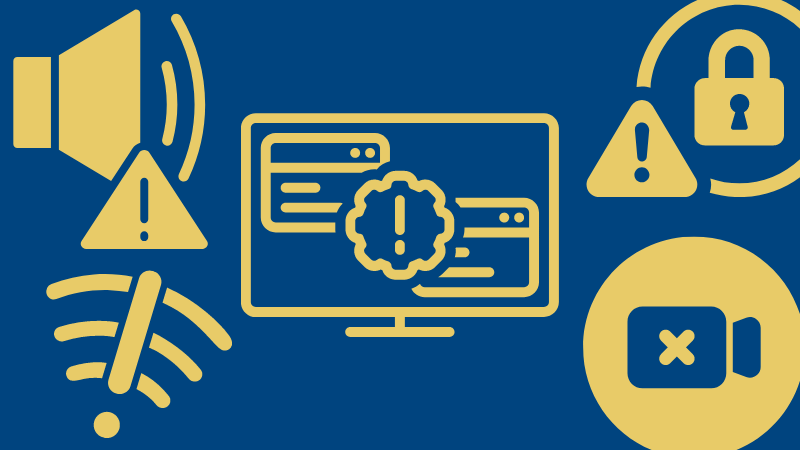Virtual meetings have become the backbone of modern business communication. Whether you’re coordinating with remote teams, meeting with international clients, or conducting training sessions, video conferencing is now essential to how we work.
But here’s the reality: 90% of online meetings start with apologies for technical delays, according to recent industry research. These disruptions aren’t just frustrating—they waste time, drain budgets, and damage credibility with clients and stakeholders.
In this guide, we’ll break down the five most common video conferencing challenges and provide actionable solutions to help you run smoother, more productive meetings—no matter where your team is located.
1. Poor Audio Quality
The Problem
Nothing derails a meeting faster than poor audio. Whether it’s echoing, choppy sound, or delayed responses, audio issues make it nearly impossible to communicate effectively. Participants struggle to follow conversations, miss critical information, and leave meetings feeling frustrated.
For remote teams, bad audio can make collaboration feel unprofessional and ineffective. Over time, this leads to lower engagement and reluctance to use the platform altogether.
Why It Happens
Poor audio quality is typically caused by:
- Low bandwidth or unstable internet connection
- Outdated or incompatible audio hardware
- Software limitations that don’t optimize for varying network conditions
- Background noise and lack of proper microphone settings
The Solution
To ensure crystal-clear audio in every meeting:
- Use a video conferencing platform optimized for low-bandwidth environments. Convay, for example, delivers enhanced audio quality even on slower connections, ensuring participants can hear each other clearly regardless of internet speed.
- Invest in quality microphones and headsets. USB or Bluetooth headsets with noise-canceling features significantly improve audio clarity.
- Test your setup before meetings. Run a quick audio check to identify and resolve issues before participants join.
- Encourage participants to mute when not speaking to reduce background noise and prevent audio feedback.
2. Poor Video Quality
The Problem
Blurry video, pixelated screens, and frozen frames make it hard to read body language and maintain engagement. When video quality suffers, remote participants feel disconnected—unable to see visual cues, presentations, or shared screens effectively.
Camera malfunctions or delayed video feeds can also make team members feel excluded, reducing their ability to contribute meaningfully to discussions.
Why It Happens
Video quality issues are often caused by:
- Insufficient upload speeds (video requires more bandwidth than audio alone)
- Outdated cameras or device hardware
- Software that doesn’t adapt to fluctuating network conditions
- Improper lighting that makes it difficult for cameras to capture clear images
The Solution
To maintain high-quality video in all conditions:
- Choose a platform designed for seamless video connectivity. Convay maintains stable video quality even in low-bandwidth scenarios, ensuring participants stay visible and engaged.
- Check your internet upload speed (aim for at least 3-5 Mbps for HD video).
- Use proper lighting. Position yourself facing a natural light source or invest in a simple ring light to improve video clarity.
- Close unnecessary applications to free up bandwidth and processing power.
- Turn off video temporarily during bandwidth-intensive tasks like screen sharing or large file transfers.
3. Unstable Internet Connection
The Problem
An unstable internet connection is the root cause of most video conferencing issues. Dropped calls, frozen screens, delayed audio, and inability to share screens can all be traced back to network instability.
For organizations with distributed teams across different regions—or those in areas with limited connectivity—these issues can make remote collaboration nearly impossible.
Why It Happens
Internet instability stems from:
- Low download/upload speeds
- Network congestion during peak usage hours
- Wi-Fi interference from other devices or physical barriers
- Outdated routers or poor network infrastructure
The Solution
To ensure stable connectivity during meetings:
- Use a wired Ethernet connection instead of Wi-Fi whenever possible. Wired connections are more stable and less prone to interference.
- Test your internet speed regularly using tools like Speedtest.net. Aim for at least 5-10 Mbps download and 3-5 Mbps upload for smooth video calls.
- Choose a video conferencing platform optimized for low-bandwidth environments. Convay’s intelligent bandwidth optimization ensures meetings run smoothly even when network conditions aren’t ideal.
- Schedule meetings during off-peak hours to avoid network congestion.
- Upgrade your router if you’re consistently experiencing connectivity issues.
4. Security Vulnerabilities
The Problem
Security is one of the most critical concerns in virtual communication. Video conferences often involve sensitive discussions—from confidential business strategies to proprietary data to personal employee information.
Without robust security measures, video meetings are vulnerable to:
- Unauthorized access (meeting crashers or “Zoombombing”)
- Data breaches during file sharing or screen sharing
- Eavesdropping on private conversations
- Compliance violations (especially in regulated industries like healthcare, finance, and government)
Why It Happens
Security issues arise from:
- Weak or default meeting passwords
- Lack of end-to-end encryption
- Outdated software with unpatched vulnerabilities
- Insufficient access controls (no waiting rooms, open meeting links)
The Solution
To protect your meetings and data:
- Choose a platform with enterprise-grade security. Convay uses AES-256 encryption, SOC-2 compliance, and country/domain locks to ensure your meetings stay private and secure.
- Enable waiting rooms to screen participants before they join.
- Use strong, unique meeting passwords and avoid sharing meeting links publicly.
- Regularly update your software to ensure you have the latest security patches.
- Implement multi-factor authentication (MFA) for an additional layer of protection.
- For highly sensitive meetings, use on-premise or self-hosted solutions to maintain complete control over your data and infrastructure.
5. Software Compatibility and Functionality Issues
The Problem
Nothing is more frustrating than discovering—mid-meeting—that participants can’t join because the platform isn’t compatible with their device. Whether it’s outdated software, unsupported operating systems, or missing features, technical compatibility issues disrupt meetings and lower productivity.
Frequent bugs, crashes, or confusing interfaces can also discourage participants from using the platform altogether.
Why It Happens
Compatibility issues occur when:
- Video conferencing software isn’t optimized for all devices (desktops, laptops, tablets, smartphones)
- Participants use outdated software versions
- The platform lacks cross-platform support (Windows, macOS, Linux, iOS, Android)
- Users aren’t properly trained on how to troubleshoot common problems
The Solution
To ensure seamless functionality across devices:
- Use a platform that supports all major devices and operating systems. Convay is fully compatible with Windows, macOS, Linux, iOS, and Android, ensuring every participant can join without technical barriers.
- Keep software updated to the latest version to eliminate bugs and improve performance.
- Provide training and documentation to help users troubleshoot common issues independently.
- Test the platform ahead of time with your team to identify and resolve compatibility issues before important meetings.
- Choose a platform with responsive customer support to quickly address technical problems when they arise.
Conclusion: Choose the Right Platform for Seamless Collaboration
Virtual meetings don’t have to be a constant battle against technical challenges. By understanding the most common issues—poor audio quality, poor video quality, unstable internet, security vulnerabilities, and compatibility problems—you can take proactive steps to create smoother, more productive meetings.
The platform you choose matters. Look for solutions that prioritize:
Optimized audio and video quality (even on low bandwidth)
Enterprise-grade security (end-to-end encryption, compliance-ready)
Cross-platform compatibility (works on all devices and operating systems)
Reliable performance (minimal downtime, intelligent bandwidth management)
Ease of use (intuitive interface, simple troubleshooting)
Convay is built to address these challenges head-on. With AI-powered optimization, sovereign security, and seamless cross-device functionality, Convay ensures your meetings run smoothly—no matter where your team is located or what network conditions they’re facing.
Ready to upgrade your virtual meetings?
Compare Convay vs other platforms


